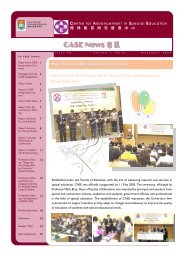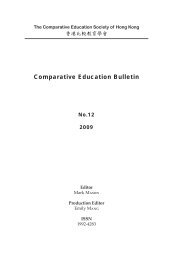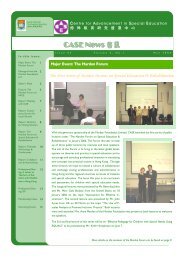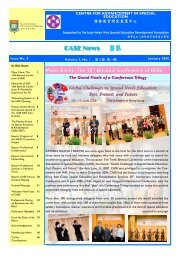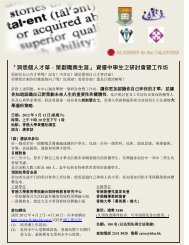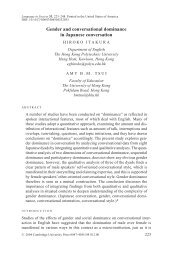Comparative Education Bulletin - Faculty of Education - The ...
Comparative Education Bulletin - Faculty of Education - The ...
Comparative Education Bulletin - Faculty of Education - The ...
You also want an ePaper? Increase the reach of your titles
YUMPU automatically turns print PDFs into web optimized ePapers that Google loves.
more than one discipline. … <strong>The</strong>se organizations are not concerned,<br />
as the disciplines are, to validate any one logically distinct form <strong>of</strong><br />
expression. <strong>The</strong>y are not concerned with developing a particular<br />
structuring <strong>of</strong> experience. <strong>The</strong>y are held together simply by subject<br />
matter , drawing on all forms <strong>of</strong> knowledge that can contribute to them.<br />
[emphasis added]<br />
Thus, the unifying epistemological element <strong>of</strong> an academic field<br />
is its material object or phenomena <strong>of</strong> study, or its practical pursuit.<br />
<strong>The</strong> approaches which a field uses to study that object are multiple<br />
and are drawn from more than one discipline. Jantsch (1972) thus<br />
distinguishes among the terms multidisciplinarity, pluridisciplinarity,<br />
crossdisciplinarity, interdisciplinarity and transdisciplinarity. Of relevance<br />
to Hirst’s definition <strong>of</strong> a field is the concept <strong>of</strong> interdisciplinarity,<br />
which refers to the cooperation within a group <strong>of</strong> related disciplines<br />
that pursue a common higher purpose. This higher purpose could be<br />
synoptic or instrumental (Lynton, 1985, cited in Klein, 1990, p.41). A<br />
synoptic justification for interdisciplinarity rests on arguments for<br />
unity and synthesis in knowledge, on modern synthetic theories and<br />
integrative concepts, and on the work <strong>of</strong> individual synthesizers, while<br />
an instrumental justification arises from the need to solve problems<br />
that may be either social or intellectual in origin, but usually practical.<br />
Bailis (1986, cited in Klein, 1990, p.53) cautions that instrumental<br />
interdisciplinarity divorced from philosophical contemplation<br />
(synoptic quest for unity <strong>of</strong> knowledge) constitutes a threat to a<br />
true interdisciplinarity that brings with it a broader understanding<br />
<strong>of</strong> the world. <strong>The</strong>se concepts <strong>of</strong> the field and interdisciplinarity are<br />
particularly useful in examining the nature <strong>of</strong> comparative education,<br />
which is <strong>of</strong>ten designated by scholars as an interdisciplinary field <strong>of</strong><br />
study.<br />
In terms <strong>of</strong> their structural or sociological features, academic<br />
fields and ‘interdisciplines’ are as difficult to delineate as are their<br />
epistemological boundaries. According to Klein (1990), a field’s presence<br />
and importance are largely determined by its relative visibility, which<br />
may take at least two forms: (1) the ‘overt’ form <strong>of</strong> interdisciplinary<br />
institutions (e.g. having a single umbrella organization or having<br />
interdisciplinary graduate programs, or interdisciplinary think tanks);<br />
(2) the commonly less overt forums for interdisciplinary dialogue<br />
(e.g. study groups, symposia, conferences, publications, and institutes<br />
similar or akin to an “invisible college” [Crane, 1972]), which refers<br />
to a communication network <strong>of</strong> productive scientists linking separate<br />
6 It seems that Hirst uses the term ‘subject matter’ differently from the sense which<br />
Heckhausen gave to it as “the point <strong>of</strong> view from which a discipline looks upon the<br />
material field or object”. In this context, Hirst seems to refer instead to the “material<br />
field or object”.<br />
13






